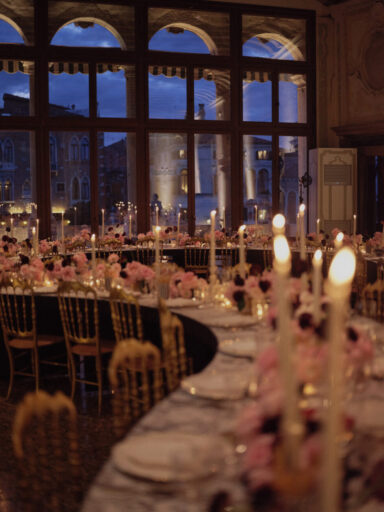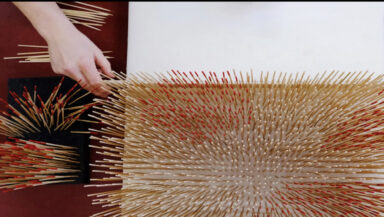Founded in 1900 and situated in the Swiss district of Locarno, Ticino, the so-called Mountain of Truth has since been an oasis of cultural and spiritual ferment. On April 1, the museum-converted complex has opened its doors to the public again for a series of events spanning over the course of the coming months

Elisàr von Kupffer, Il chiaro mondo dei beati, 1924-1939. Detail of the painting following restoration, 2021. Ph: Claudio Berger. Courtesy Fondazione Monte Verità
Text by: Gilda Bruno
“Ascona in the early 20th Century? It was the appointed place for utopia,” explains journalist and art critic Beba Marzano in a statement about the Swiss eclectic paradise.
The dream come true of Henri Oedenkoven, a Dutch entrepreneur with roots in Antwerp, Belgium, Ida Hofmann, a piano teacher from Montenegro, Berlinese Professor Lotte Hattemer, and that of the Transylvanian Gräser brothers among other intellectual personalities, Monte Verità (Mountain of Truth) was born as a pioneering attempt at escaping urbanised society in favour of a vegan and nudist life experience.
Striving for a healthier and less artificial way of conceiving existence, the founders of this utopian reality rapidly turned the Monescia mountain — a hill overlooking Ascona where the multifaceted community settled — into the ultimate cradle of idealism. A place where the most revolutionary thinkers of that time, from philosophers to psychoanalysts, from journalists to playwrights, anarchists, and theosophists, not to forget a thriving group of artists, could come together and disrupt societal norms to cultivate a life fully devoted to Mother Nature.
A valid alternative to the capitalist and communist blocks that would have soon permeated the financial and cultural fabric of postwar Europe, through the years, Monte Verità became the temporary home of thought-provoking figures such as Carl Gustav, Hermann Hesse, Isadora Duncan, Marianne Werefkin, Alexej von Jawlensky, Franz Kafka, and David Herbert Lawrence.
“Draped in loose flowing garments and with long hair they worked in the gardens and fields, built spartan timber cabins, and found relaxation in dancing and naked bathing, exposing their bodies to light, air, sun, and water,” reads the historical section of the Monte Verità’s website: the digital platform of the once-remote mystical heaven now repurposed as a state-of-the-art congress and cultural centre run by the homonym Foundation.

Group portrait. Courtesy Fondazione Monte Verità e
Fondo Harald Szeemann
“Their diet excluded all animal foods and was based entirely on plants, vegetables, and fruit. They worshipped nature, preaching its purity and interpreting it symbolically as the ultimate work of art: ‘Parsifal’s meadow,’ ‘The rock of Valkyrie,’ and the ‘Harrassprung’ were symbolic names which with time were adopted even by the local population of Ascona who had initially regarded the community with suspicion,” the website narrates.
The original social structure of Monte Verità saw reciprocal cooperation among all members of the community as a fundamental prerogative. Among the others, the anachronistic colony aimed at achieving “the emancipation of women, self-criticism, new ways of cultivating mind and spirit, and the unity of body and soul.” Nonetheless, the first wave of inhabitants of the hill — prevalently composed of like-minded individuals who did not recognise themselves in the traditional way of living — was progressively replaced by the arrival of a counterculture movement of artists which, in the long run, transformed the Mountain of Truth into a flourishing hub of aesthetes.
Proving how the legacy of such an unprecedented socio-cultural phenomenon still echoes 121 years after its establishment, the Monte Verità Foundation has just made its comeback to the international stage with a calendar full of events that will accompany the public throughout the rest of 2021. The Spring programme of the institution debuted on April 1 with the display of Elisàr von Kupffer’s (1872-1942) majestic polyptych Chiaro mondo dei beati: serving as the “seal” of the recently-renovated museum complex, the masterpiece is now exhibited in the Padiglione Elisarion under the curatorial expertise of Harald Szeemann.

Francesca Gagliardi Corona
In May, the Monte Verità classic review Giardini in Arte will leave the floor to artists Francesca Gagliardi, Marco Cordero, Johanna Gschwend, and Moritz Hossli for a showcase of works celebrating the primordial connection linking nature and art. Later on in the same month, the Foundation will welcome a new version of Michelangelo Pistoletto’s Terzo Paradiso: made of the stones of Monte Verità’s hill, the creation will then be donated to the cultural centre by the artist himself. The first weeks of July will then see multidisciplinary artist Fabrizio Dusi grace the Switzerland-based art hub with site-specific artworks dedicated to the idea of anarchic paradise.
The month of August will then be studded with the performances and stage readings of Cabaret Voltaire, which will immerse the audience into the world of the Dada movement and narrate how its origins relate to the ideals promoted by Monte Verità. The live events will also take the form of lectures where topics as diverse as the female universe of the Baroness Saint Léger, Olga Fröbe Kapteyn, and Charlotte Bara, the protagonists of the Casa Anatta museum, and the production of painter Joseph Beuys will be discussed to stimulate engaging discussions. Finally, artist, narrator, and actress Stefania Mariani will lead a theatrical walk into nature, granting spectators a unique immersive experience.
“Planning the proposals for the public has been quite a demanding task over the past twelve months,” points out Nicoletta Mongini, Cultural Manager of the Monte Verità Foundation. “Our compass has always remained focused on dialogue, as well as on meeting and exchanging with the people who, as soon as possible, will be back at Monte Verità. The reflections and stimuli that in this last year have involved the international population have solidified our awareness of representing a place where nature, interiority, spirituality, art, and beauty were founding principles that were never overlooked. We hope to be able to welcome new visitors soon so as to continue to cultivate the spirit of the mountain.”
Visit Monte Verità’s website to discover all the initiatives promoted by the Foundation.


